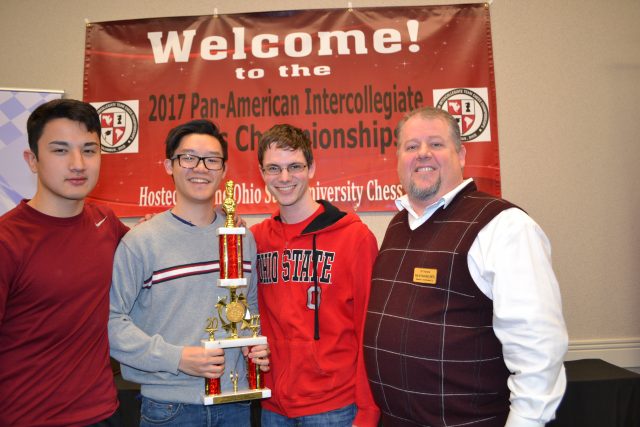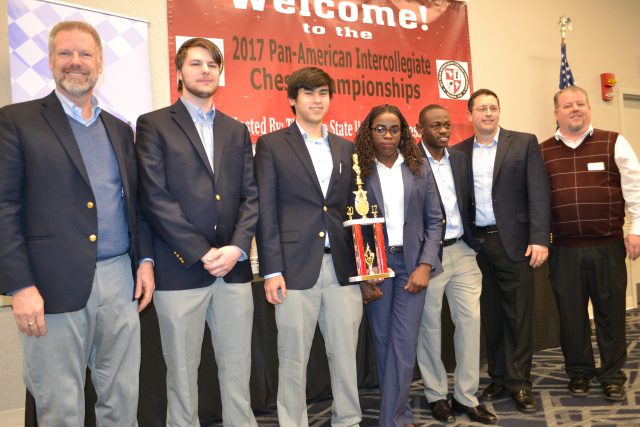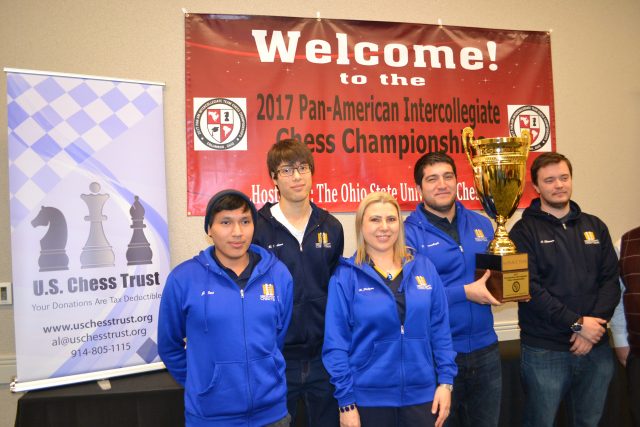 GM Jorge Cori, GM Ray Robson, GM Susan Polgar, GM Vasif Durarbayli (holding trophy), GM Alex Shimanov. Photo Al Lawrence
GM Jorge Cori, GM Ray Robson, GM Susan Polgar, GM Vasif Durarbayli (holding trophy), GM Alex Shimanov. Photo Al LawrenceThe titanic trophy-cup in shining gold-tint stood just a bit taller than the four silver cups in its row, any of which looked as if it could commemorate first place for Wimbledon. For four days players and coaches stole glances at the big one. But the truth is that, at the onset, most of the 52 U.S. teams would have settled for any of the top four trophies because that would put them into the Final Four of College Chess, the April playoff that crowns a U.S. collegiate team champion. And if UT-Dallas could predict that, through its new strategy compiling team rosters, three of its teams would be sitting at the top four tables in the last round, I’d have to think that would have been a welcome glimpse into the future. But as any “Vikings” fan knows, peeks into the misty future offer a distorted view. Unlike the World Series, the PanAms is truly international. In fact, this year half a dozen teams from outside the U.S. traveled to the event hosted by Ohio State University in Columbus, Ohio, to challenge recent U.S. dominance. Two teams came from Mexico. Four from Canada, including Toronto Hart House, a six-time champ, but not since 1982. The 58 four-board squads played team-on-team, paired under the Swiss system. Universities can enter more than one team. Round 4: Big time games The top teams begin squaring off Friday morning. Top-rated Webster University “A,” with an average rating of 2724, can’t be budged from Table 1 as it beats University of Texas-Dallas “A’s” all-GM team. Meanwhile, second-seed Saint Louis University (SLU), the only other team with a US Chess average rating above 2700, triumphs by the narrowest margin, 2 ½-1 ½ , over Texas Tech “A,” and University of Texas-Rio Grande Valley “A” manages to beat Webster “B.” Round 5: Top two teams on Table 1 Round 5 finally sees the top two seeds, Webster U. and SLU, both at 4-0, face off on Table 1. Oddly, SLU settles for expeditious draws on Boards 1. 2, and 4. That leaves its third-board GM Yaro Zherebukh with the black pieces against GM Ray Robson, a U.S. Championship competitor in his sixth year at Webster and playing in his final PanAms. Now in graduate school at SLU, Zherebukh lost a long, tough game in Round 4 to GM Pavlo Vorontsov of Texas Tech, so the decision to bank it all on Yaro Z has some scratching their heads. Spectators and coaches closely follow Robson-Zherebukh. It’s a key game. But it’s also compelling because it is perhaps the most difficult game to assess in the whole event—an imbalance of pieces and pawns. https://twitter.com/SusanPolgar/status/946909951083073537 “It was the most important game of this PanAm for our team, and a brilliant game by Ray,” Webster’s Paul Truong said.
[pgn] [Event "Pan-American Championships"] [Site "?"] [Date "2017.12.29"] [Round "?"] [White "Robson, Ray"] [Black "Zherebukh, Yaro"] [Result "*"] [ECO "C65"] [Annotator "Lawrence,Al"] [PlyCount "103"] [EventDate "2017.??.??"] [SourceDate "2018.01.02"] 1. e4 e5 2. Nf3 Nc6 3. Bb5 Nf6 4. d3 Bc5 5. Bxc6 dxc6 6. Nbd2 Nd7 7. Nc4 f6 8. O-O O-O 9. Nh4 Rf7 10. Be3 Bf8 11. Kh1 Nb6 12. Na5 Na4 13. Qe1 Qe8 14. b3 Nc5 15. g3 b6 16. Nc4 Bh3 17. Rg1 Qd7 18. f3 Be6 19. f4 exf4 20. gxf4 Bxc4 21. bxc4 Nxd3 22. cxd3 Qxd3 23. Bf2 Re8 24. Nf5 Rd7 25. Qe3 Qxc4 (25... Qxe4+ 26. Qxe4 Rxe4 27. Rad1 Rxd1 28. Nh6+ Kh8 29. Nf7+ Kg8 30. Nh6+ {may have been a way to a draw neither may have wanted.}) 26. Rae1 Qxa2 27. Qf3 Kh8 28. Bd4 Qf7 29. Ba1 g6 (29... Qe6 30. Nd4 Qc4 31. e5 Rxd4 32. Bxd4 Qxd4 33. Rd1 Qc4 34. exf6 gxf6 35. Rd7 {Here Stockfish 8 likes White. I think most human players would agree. One fantasy line is:} Bh6 36. Qe3 $3 {and Black is lost.}) 30. Ng3 (30. Nh4) 30... Bc5 31. f5 Bd4 ({Yaro is obviously wary of} 31... Bxg1 32. Rxg1 {But perhaps it's best:} Rd6 33. Qf4 Qe7 {when both sides are still in the game. After the exchange of dark-square bishops, Black is lost.}) 32. Bxd4 Rxd4 33. fxg6 hxg6 34. Nf5 $1 gxf5 35. Qe3 $3 Rd7 36. Rd1 Rg8 (36... Rxd1 37. Qh6+ Qh7 38. Qxf6+) 37. Qh6+ Qh7 38. Qxf6+ Rdg7 39. Rd7 {Even four pawns up, it's a dreadful predicament for Black.} fxe4 {Make that five pawns up.} 40. Rgxg7 Rxg7 41. Rd8+ Qg8 42. Qh4+ Rh7 43. Rxg8+ Kxg8 44. Qd8+ Kf7 45. Qxc7+ Kg6 46. Qxc6+ Kf5 47. Kg2 Re7 48. Kf2 e3+ 49. Ke2 Re6 50. Qd5+ Kf6 51. h4 a5 52. h5 { 1-0--It's hopeless: 52. ... a4 53. h6 Re8 54. h7; or 52. ... Ke7 53. Qg5+ Kf7 54.h6.} * [/pgn]
Round 6: Has UT-Dallas cracked the code? Webster remains camped on Table 1, the only team with a perfect 5-0. UT-Dallas “B” stands in clear second with 4 ½, having given up a draw against UT-RGV “B” in Round 4. Any of a college’s teams can win the Final Four spot for its school, or even first place, as Webster “B” once did. So UT-Dallas “B” could certainly play for the top spot. Eight other teams are a full point behind Webster “A.” Six of the eight are scholarship powerhouses. The final pairings with average US Chess ratings: Table 1: UT-Dallas “B” (2560) v. Wester “A” (2724) Table 2: SLU (2702) v Harvard Crimson (2422) Table 3: UT-Dallas “A” (2593) v. UT-RGV “A” (2650) Table 4: Webster “B” (2634) v. UT-Dallas “C” (2529) Table 5: U. of Illinois “A” (2088) v. Texas Tech “A” (2615) So in the final round, three(!) UT-Dallas teams are still in the running for the Final Four, and one team still has a shot for first-place at the PanAms. That encouraging scenario was a result of UT-Dallas’ Program Director James Stallings’ new strategy. Instead of loading up one team to have the highest rating, he put together three teams within a few points of each other. “That way we’d have three chances to qualify.” And that approach reinforces the mindset that qualifying in the top four is the first priority. Just a bit like Bobby Fischer’s dictum to first equalize as Black. With three of his teams within the roped-off four tables on Saturday morning, Stallings’ plan seems to be working—especially as UT-Dallas “B” is first to nick Webster “A” with a drawn match. With 5 ½- ½, Webster “A” finishes in clear first regardless of other results. And UT-Texas “B” closes out the event with 5-1, the only other undefeated team. All cause for cautious optimism. On Table 2, SLU is up against a serious non-scholarship challenger, Harvard, a school with a prestigious chess history. But it hasn’t been in the Final Four since the second one in 2002. GM Darwin Yang plays Board 1, backed up by IM Richard Wang, FM Varun Krishnan and NM Bryan Hu. [pgn] [Event "2017 Pan-American Intercollegiate Chess "] [Site "Columbus, Ohio"] [Date "2017.12.30"] [Round "6.8"] [White "Hu, Bryan"] [Black "Rambaldi, Francesco"] [Result "0-1"] [ECO "D48"] [Annotator "Lawrence,Al"] [PlyCount "74"] [EventDate "2017.??.??"] [TimeControl "6000+1580"] [WhiteClock "0:02:38"] [BlackClock "0:27:18"] {SLU's GM FRancesco Rambaldi wins a sprightly Round 6 game against Harvard Crimson's Bryan Hu.} 1. d4 d5 2. c4 c6 3. Nf3 Nf6 4. Nc3 e6 5. e3 a6 6. Bd3 dxc4 7. Bxc4 b5 8. Bd3 c5 9. O-O Bb7 10. Qe2 Nbd7 11. Rd1 cxd4 12. Nxd4 Bd6 13. e4 Qe7 14. Bg5 O-O 15. Rac1 Rfd8 16. Nf3 h6 17. e5 ({The game-move gives Black a big and lasting edge. Instead, White could first use his attacked bishop as a desperado.} 17. Bxh6 gxh6 18. e5 Nxe5 19. Nxe5) 17... Nxe5 18. Bxf6 Qxf6 19. Nxe5 Qxe5 20. Qxe5 Bxe5 21. Bf1 Rac8 22. Rxd8+ Rxd8 23. Rd1 Rxd1 24. Nxd1 Kf8 25. g3 Ke7 26. Bd3 Bf3 27. Nc3 Bxc3 28. bxc3 Bd5 29. a3 e5 30. f4 e4 31. Be2 Bc4 32. Bg4 e3 33. Bf5 Kd6 34. Bb1 Kc5 35. Kg2 Bd5+ 36. Kf1 Kc4 37. Ba2+ Kxc3 { After 38. Bxd5 Kd2 39. Bf3, 39. ... a5 wins simply.} 0-1 [/pgn]
The all-GM SLU team manages a 3-1 victory over Harvard Crimson. SLU joins the 5-1 group. In a Texas shoot-out on Table 3, UT-RGV "A" hands UT-Dallas “A” a 3 ½ - ½ shellacking. UT-D’s best is out of the running. The Rio Grande Valley team joins the Hopeful Fives. Texas Tech “A” draws the long straw in its final round matchup against the University of Illinois “A,” but it’s a forced pairing. Illinois squads had qualified for the Final Four in 2013 and 2014, vaulting over some well-funded chess scholarship programs. So the Illini squad is never to be taken lightly. This year, its lineup of a NM Duncan Shepherd, Experts Cale Denby and Nathaniel Kranjic and A-player Allen Guo had solid results. But the four couldn’t stand up to a Texas Tech “A” team hungry for the tiebreaks that lopsided scores yield. Tech finishes with a 4-0 sweep in Round 6. Tech joins the Hopeful Five. Texas Tech “A’s” GM Pavlo Vorontsov, who had earlier defeated SLU’s Zherebukh, a former U.S. Championship participant, finishes with an uncommon, and almost unthinkable, 6-0 on a qualifying team—and the only perfect score in the event. “Pavlo has gained a hundred rating points since reporting to Texas Tech,” Program Director and Coach GM Alex Onischuk said. In the last round, Vorontsov shows his willingness to go for the king, even as Black. [pgn] [Event "2017 Pan-American Intercollegiate Chess"] [Site "?"] [Date "2017.12.30"] [Round "?"] [White "Kranjc"] [Black "Vorontsov"] [Result "0-1"] [ECO "B23"] [Annotator "Lawrence,Al"] [PlyCount "38"] [EventDate "2017.??.??"] [SourceDate "2017.12.30"] {Going into the final round, only Webster U. boasted a perfect score. UTD-B had 4.5 but had to face Webster on Board 1. Eight others at 4-1 had to face each other, scrambling for one of the prize spots in the Final Four to move on to New York for the Easter weekend playoffs. GM Pavlo Vorontsov, on third board for Texas Tech A, quickly did his part by sacking the house against an opponent who had let his troops stray too far from the killing zone.} 1. e4 c5 2. Nc3 Nc6 3. Bb5 e5 4. Bxc6 dxc6 5. d3 Bd6 6. Be3 Nf6 7. Qd2 O-O 8. h3 Nd7 9. O-O-O b5 10. f4 b4 11. Nce2 Qa5 12. Kb1 Nb6 13. b3 exf4 14. Nxf4 Be5 15. Nf3 Bc3 16. Qf2 Rb8 17. Qg3 (17. Ne2) 17... Nc4 18. dxc4 Qxa2+ 19. Kxa2 Rb6 { After the sacrifice of a knight and a queen, a deadly "quiet move." There's no escaping mate after ... Ra6 and ... Ra1. The mortified cluster of White's misplaced big guns can only stand and watch the regicide.} 0-1 [/pgn]
Closing drama Kelly Bloomfield ran one of the best thought-out and executed PanAms in the long history of the event. The playing hall was spacious, with wide aisles between the tables. There was no chair-bumping here, even at the lowest tables. Coffee and tea greeted players at the start of every round, provided by new sponsor Akuna Capital. The kick-off reception, partially sponsored by the U.S. Chess Trust, gave players a chance to meet one another while munching on great food and viewing projected photos of past PanAms. And Bloomfield is a gutsy promoter. You’d have to say organizing the PanAms is a gutsy move by itself. But consider his suppressing the final standings until the formal closing ceremony at 3 p.m., hours after the last OTB handshake. The directors of four poshly-funded chess scholarship programs with teams tied for 2nd-5th knew one of them had to be left out of the Big Show in April. They weren’t used to waiting to find out. Eager to email their college brass—and to know whether a final drink at the Hyatt Regency bar would be celebratory or sorrow-drowning. But Kelly knew that’s what the closing ceremony is for, convinced more people would attend if the announcements were news. He turned out to be right. The playing-hall-now-auditorium brimmed with the biggest crowd ever seen for the final formalities—at least 200 of the 258 players. Then, of course, Kelly made the announcements in reverse order, awarding the many other division and special awards while five program directors held their breath. Only Webster’s GM Susan Polgar knew her defending champs had finished first and were safely in the championship playoff. In the end, UT-Dallas was the hard-luck story of the 2017 PanAms. Despite three teams contending for glory in the final round, despite its “B” team finishing as the only undefeated squad other than Webster “A” and being the only team to draw Webster “A,” UT-Dallas placed last of the five 5-point teams on tiebreaks. Perhaps only the University of Central Florida’s 13-0 football team’s not being in the playoffs surpasses the frustration. (And by the way, since UCF sent two teams to the PanAms, I’m backing its gridiron claim to being number one.) Qualifiers for the Final Four can send a team made up of any players they choose, so rosters of the U.S. collegiate hopefuls aren’t known. But here are the four schools, with the players that clinched the spots for their schools: Webster U.
--GMs Alex Shimanov, Jorge Cori, Ray Robson, Vasif Durarbayli Saint Louis U.
Texas Tech U. 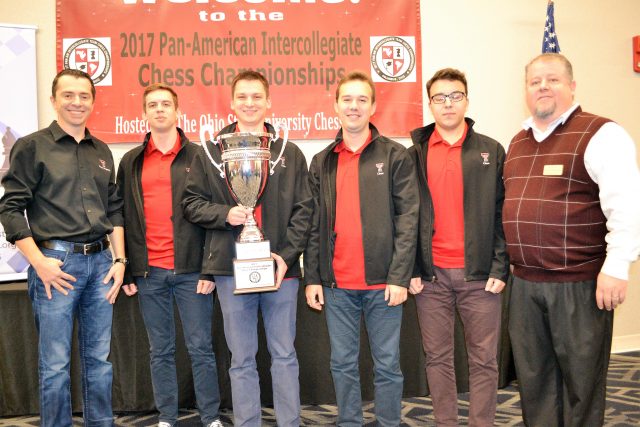 The TTU team: Coach GM Alexander Onischuk, IM Evgen Shtembuliak, GMs Andrey Baryshpolets, Sergei Matsenko and Pavlo Vorontsov with Kelly Bloomfield, Photo Al Lawrence University of Texas-Rio Grande Valley
The TTU team: Coach GM Alexander Onischuk, IM Evgen Shtembuliak, GMs Andrey Baryshpolets, Sergei Matsenko and Pavlo Vorontsov with Kelly Bloomfield, Photo Al Lawrence University of Texas-Rio Grande Valley 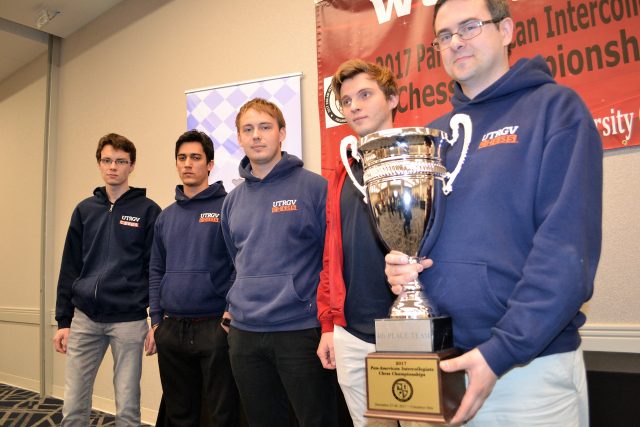 GMs Kamil Dragun, Carlos Hevia Alejano, Andrey Stukopin, Vladimir Belous and coach GM Bartek Macieja, Photo Al Lawrence Thus Webster adds to its impressive string of chess victories. Since 2013, it has won every PanAms in clear first except for 2015, when it tied with the winner on tiebreaks, Texas Tech. (But top score groups are considered co-champions under U.S.Chess rules.) Webster has won every Final Four since the first it could compete in, 2013. Before that GM Polgar guided Texas Tech to Final Four victories in 2011 and 2012. “The goal of our team, especially the A team,” Webster Universities Paul Truong said, “is never to be out of Table 1 for any round. And the goal of the B team is never to leave the area of the top four Tables. As long as we are there every round, we have a chance to win or at least make the Final Four.” Division and other team winners
GMs Kamil Dragun, Carlos Hevia Alejano, Andrey Stukopin, Vladimir Belous and coach GM Bartek Macieja, Photo Al Lawrence Thus Webster adds to its impressive string of chess victories. Since 2013, it has won every PanAms in clear first except for 2015, when it tied with the winner on tiebreaks, Texas Tech. (But top score groups are considered co-champions under U.S.Chess rules.) Webster has won every Final Four since the first it could compete in, 2013. Before that GM Polgar guided Texas Tech to Final Four victories in 2011 and 2012. “The goal of our team, especially the A team,” Webster Universities Paul Truong said, “is never to be out of Table 1 for any round. And the goal of the B team is never to leave the area of the top four Tables. As long as we are there every round, we have a chance to win or at least make the Final Four.” Division and other team winners 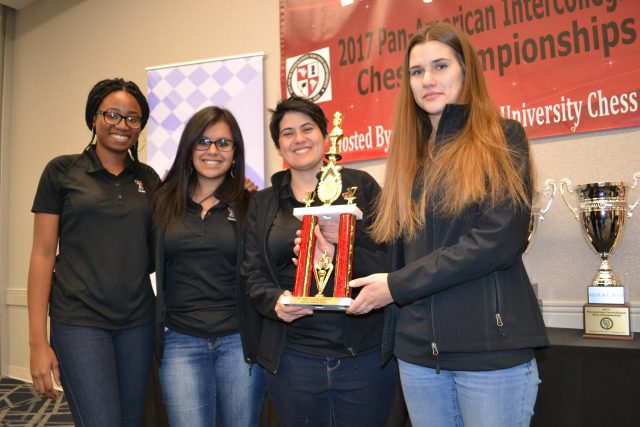 The TTU all female team: Opuriche "Ify" Duruocha, Claudia Elizabeth Munoz, Carla Heredia and Iryna Andrenko, Photo Al Lawrence The PanAms award a lot of impressive hardware to take back to campus. And division prizes are hotly contested. Arizona State University “A” (2153) took Division II honors, finishing an impressive 13th overall. University of Maryland-College Park (1952) won top Division III. Ohio State University-Scarlet (1785) took home the Division IV brass. Queen’s University (Ontario, Canada) won Division V.
The TTU all female team: Opuriche "Ify" Duruocha, Claudia Elizabeth Munoz, Carla Heredia and Iryna Andrenko, Photo Al Lawrence The PanAms award a lot of impressive hardware to take back to campus. And division prizes are hotly contested. Arizona State University “A” (2153) took Division II honors, finishing an impressive 13th overall. University of Maryland-College Park (1952) won top Division III. Ohio State University-Scarlet (1785) took home the Division IV brass. Queen’s University (Ontario, Canada) won Division V.
University of Toronto “A” (Hart House) continued a long and prestigious history of PanAms honors, winning the Top International award. Texas Tech “B” was Top All-Women Team. Washington University in St. Louis was Top Mixed Doubles team. Northwest U., from Kirkland, Washington, took Top Small College, defeating Oberlin College, who had owned that title for the previous four years. Phiona Mutesi, whose early chess career despite living in the slums of Uganda was the basis for the 2016 film “Queen of Katwe,” contributed a key win in that crucial round for Northwest, where Phiona is a scholarship student.
Oberlin, who had reigned for four straight years as Small College champ, didn’t go home empty handed. Coach Constantine Ananiadis left with the Biggest Team Upset award. Top Board Winners GM Tanguy Ringoir of University of Maryland Baltimore County was top Board 1 with 5 ½ - ½. IM Safal Bora of University of Michigan “A” was Top Board 2 with 5 ½. GM Pavlo Vorontsov of Texas Tech was top Board 3 with the tournaments only 6-0 score. IM Evgen Shtembuliak, also of Texas Tech, was Top Board 4 with 5 ½. Peter Gabrielides brought the Biggest Individual Upset prize back to Oberlin by defeating a player more than 900 points higher.
A storied history and many to thank The Pan-Am Intercollegiate Team Chess Championship, held every year since 1946, is open to any team comprising four players and up to two alternates from the same post-secondary school in North America, Central America, South America, or the Caribbean. Before 1964, the event alternated between an individual and a team college championship. But the popularity of playing for your team easily won out. Reuben Fine and Gata Kamsky are only a few legendary players who have fought for their teams at the PanAms.
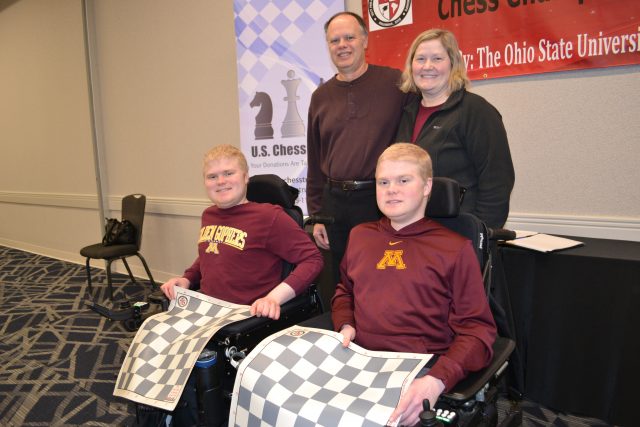 Identical twins, Jacob and Nathan Ritter (l-r) played for the University of Minnesota Twin Cities, Photo Al Lawrence
Identical twins, Jacob and Nathan Ritter (l-r) played for the University of Minnesota Twin Cities, Photo Al LawrenceThe Pan-American Intercollegiate Team Championship is a national championship sanctioned by U.S. Chess. This year’s championship was hosted and sponsored by Ohio State University with additional sponsorship from the U.S. Chess Trust and Akuna Capital of Chicago. The 2018 PanAms will be held in San Francisco. Chief Director and former U.S. Chess Executive Director and CFO Grant Perks ran an on-time event with the help of Bloomfield, who was Chief Assistant TD as well as Organizer, Kathy Lin, Ben Tancinco, Al Valentine, and Aryan Balyan.
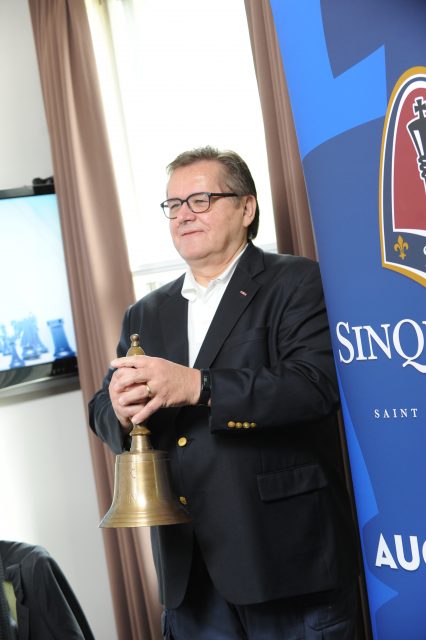 ABOUT THE AUTHOR
ABOUT THE AUTHOR
Al Lawrence is a frequent contributor to US Chess News. He recently wrote about the U.S. Armed Forces Championships. He is a two-time winner of the Chess Journalist of the Year award (2000 and 2016) and a former Executive Director of the US Chess Federation. He currently serves as the Managing Director of the U.S. Chess Trust.
Categories
Archives
- November 2025 (29)
- October 2025 (39)
- September 2025 (27)
- August 2025 (29)
- July 2025 (43)
- June 2025 (25)
- May 2025 (24)
- April 2025 (29)
- March 2025 (29)
- February 2025 (20)
- January 2025 (24)
- December 2024 (34)
- November 2024 (18)
- October 2024 (35)
- September 2024 (23)
- August 2024 (27)
- July 2024 (44)
- June 2024 (27)
- May 2024 (31)
- April 2024 (51)
- March 2024 (34)
- February 2024 (25)
- January 2024 (26)
- December 2023 (29)
- November 2023 (26)
- October 2023 (37)
- September 2023 (27)
- August 2023 (37)
- July 2023 (47)
- June 2023 (33)
- May 2023 (37)
- April 2023 (45)
- March 2023 (37)
- February 2023 (28)
- January 2023 (31)
- December 2022 (23)
- November 2022 (32)
- October 2022 (31)
- September 2022 (19)
- August 2022 (39)
- July 2022 (32)
- June 2022 (35)
- May 2022 (21)
- April 2022 (31)
- March 2022 (33)
- February 2022 (21)
- January 2022 (27)
- December 2021 (36)
- November 2021 (34)
- October 2021 (25)
- September 2021 (25)
- August 2021 (41)
- July 2021 (36)
- June 2021 (29)
- May 2021 (29)
- April 2021 (31)
- March 2021 (33)
- February 2021 (28)
- January 2021 (29)
- December 2020 (38)
- November 2020 (40)
- October 2020 (41)
- September 2020 (35)
- August 2020 (38)
- July 2020 (36)
- June 2020 (46)
- May 2020 (42)
- April 2020 (37)
- March 2020 (60)
- February 2020 (38)
- January 2020 (45)
- December 2019 (34)
- November 2019 (35)
- October 2019 (42)
- September 2019 (45)
- August 2019 (56)
- July 2019 (44)
- June 2019 (35)
- May 2019 (40)
- April 2019 (48)
- March 2019 (61)
- February 2019 (39)
- January 2019 (30)
- December 2018 (29)
- November 2018 (51)
- October 2018 (45)
- September 2018 (29)
- August 2018 (49)
- July 2018 (35)
- June 2018 (31)
- May 2018 (39)
- April 2018 (31)
- March 2018 (26)
- February 2018 (33)
- January 2018 (30)
- December 2017 (26)
- November 2017 (24)
- October 2017 (30)
- September 2017 (30)
- August 2017 (31)
- July 2017 (28)
- June 2017 (32)
- May 2017 (26)
- April 2017 (37)
- March 2017 (28)
- February 2017 (30)
- January 2017 (27)
- December 2016 (29)
- November 2016 (24)
- October 2016 (32)
- September 2016 (31)
- August 2016 (27)
- July 2016 (24)
- June 2016 (26)
- May 2016 (19)
- April 2016 (30)
- March 2016 (36)
- February 2016 (28)
- January 2016 (32)
- December 2015 (26)
- November 2015 (23)
- October 2015 (16)
- September 2015 (28)
- August 2015 (28)
- July 2015 (6)
- June 2015 (1)
- May 2015 (2)
- April 2015 (1)
- February 2015 (3)
- January 2015 (1)
- December 2014 (1)
- July 2010 (1)
- October 1991 (1)
- August 1989 (1)
- January 1988 (1)
- December 1983 (1)



